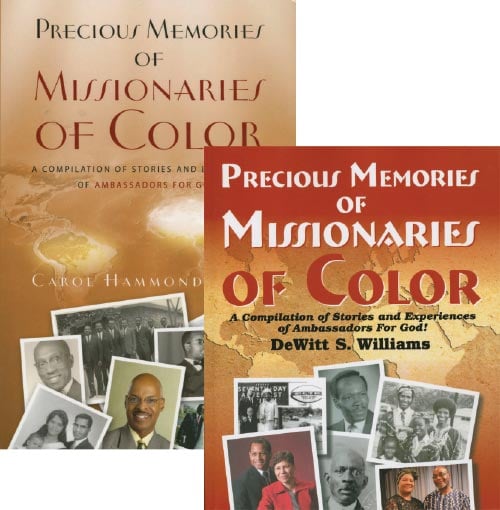
Carol Hammond’s volume 1 (Pleasant Word Publishing, 2008), and DeWitt S. Williams’ recent complementary volume (TEACH Services, 2015), with a preface by Gary Krause, director of the Office of Adventist Mission, are a unique mine of inspiration on the yeoman service of Adventist African American overseas workers between 1892 and 2008. Williams has enhanced Hammond’s work by continuing her title, clarifying information on some of her subjects, covering individuals not mentioned in volume 1, and providing alphabetical indices that integrate his data and hers. Both volumes are well supplied with historically significant photography.
Hammond’s 458 pages dedicate 49 chapters to telling of the service of 86 individuals between 1892 and 2008. A final section that might have been labeled “Appendix” begins with an alphabetical list of 187 heroes, the “Black Seventh-day Adventist Mission Service Honor Roll,” a third of whom (63) were single missionaries. Next, Maurice Battle’s letter from his mom, dated September 6, 1956, adds a quaint touch that startles by the nature and currency of its content: “As for news not much,” she says: approaching elections, race agitation, crime. Her words of love came at the beginning of Maurice and Esther Battle’s service to five overseas territories, one of the longest terms of service recounted (1956-1979), surpassed only by Dunbar and Lorraine Henri (1945-1973), and Leola and Walton Whaley (1968-1998). A poem of 111 four-line stanzas concludes the section, rhyming a-b-c-b all the way through. It is Edward Dorsey’s “Dolly Dot and Me: Our Call to Florida,” a poem mostly about service in Liberia, a long way from Florida.
Chapters are numbered in volume 2: 95 in all. Williams’ 372 pages lead off with eight names of individuals already covered in volume 1 on whom he has gathered new information. The most interesting of these duplications is probably a single woman missionary to Liberia and Sierra Leone. Though Williams correctly identifies her as Caucasian, he might also have noted her preferred spelling of her name: Hannah More. His alphabetical listing of names on pages 361-365 would read better if last names in the list were placed first (Battle, Maurice & Esther, under “B,” instead of Maurice and Esther Battle under “B”). A listing of countries would well complement the names list and the chronological listing of periods of service (pp. 367-371). Pioneer James E. Patterson opens the chronological list with his service to the Caribbean islands of Jamaica, Barbados, and Haiti, and to Panama in Central America (1892-1896). Williams’ 249 subjects include 27 singles and 111 couples, ending with Timothy and Beverly McDonald in Kenya, 2003-2007.
We all need the inspiration of these books’ history. Forgetting the Lord’s leading inspires fear. Remembering through these stories helps prepare us to say, “Here am I, Lord, send me.”
Precious Memories, volume 1, is available on Amazon; volume 2 may be obtained at your local book center; or directly from the author ([email protected]).

This CD destroys stereotypes—of Chile, of Adventist education, of Seventh-day Adventism in this stereotype-defying land. Consider, for example, Chile’s dimensions—18 times as long as it is wide at its widest point. Again, consider its diplomatic strategy: A City Called Heaven is a product of the Universidad Adventista de Chile [UnACH], whose Coro de Cámara [Chamber Choir] was selected as the nation’s ambassadors to tour the United States of America at the nation’s expense.
The strong, steady pulse of the CD’s opening title number confounds standard anticipations with the soulfulness of its sound. It moves to the measures of a heaven-bound rhythm that nothing will swerve from its purpose. Youthful voices from the south of South America pour out a sound of gospel soul most know to belong to southern America. That sound, the glorious demand to take your stand (“De Pie”), the saturated progressions and adept modulations of “Fija Tus Ojos en Cristo,” all fill you, fellow Seventh-day Adventist, with admiration and holy pride at the competence, musicality, vocal quality, genre versatility, and spiritual sincerity of these messengers for God and country. You hear and know that director Susana Ovalle Miranda knows the journey that her singers need to take, that she means for them to take us with them, and that she knows how to get us all there. Also, that the foreign ministry’s judgment in selection of these ambassadors is more than merely wise. It is inspired.
Their final plea [song 9, “Señor Jesús el día ya se fue,”] will be yours too, “Abide With Me,” for as the spirit of their selections and interpretations shows they are aware, we all need Him at every step if our journey will ever succeed.
Listen to the message, delivered in both English and Spanish, admire the orchestration of the Nashville String Machine and the Symphonic Orchestra of Prague, and be blessed, inspired, and lifted.
A City Called Heaven may be obtained through several avenues, including (1) the university (rectoria @unach.cl); (2) director Susana Ovalle ([email protected]); codirector Sergio Leiva ([email protected]).